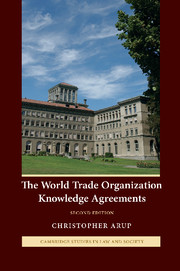Book contents
- Frontmatter
- Contents
- Preface and Acknowledgements
- List of WTO dispute rulings
- List of international instruments
- PART I GLOBALISATION, LAW AND THE WTO
- PART II SERVICES
- PART III INTELLECTUAL PROPERTY
- 6 The Agreement on Trade-Related Intellectual Property Rights
- 7 The case of genetic codes
- PART IV CONVERGENCE
- Index
7 - The case of genetic codes
Published online by Cambridge University Press: 23 February 2010
- Frontmatter
- Contents
- Preface and Acknowledgements
- List of WTO dispute rulings
- List of international instruments
- PART I GLOBALISATION, LAW AND THE WTO
- PART II SERVICES
- PART III INTELLECTUAL PROPERTY
- 6 The Agreement on Trade-Related Intellectual Property Rights
- 7 The case of genetic codes
- PART IV CONVERGENCE
- Index
Summary
Chapter 7 selects as its global carrier the essential life force of the genetic code. It considers how control of the code may exercise a powerful influence over the plants produced across the world. Just as importantly, it may shape the pattern of the benefits that stem from their production, such as farming livelihoods, food sustenance, medicines and health care. Links are made to the manipulation of genetic codes in animals and humans, partly because the technology now crosses over directly, partly because the legal issues have increasingly become the same.
In keeping with the general approach of the book, this chapter offers reasons why the technology is not all powerful and legal control matters. The dynamics of the technology do not allow entirely for production to cut loose from the ties of the locality and protection still relies on a legal foundation rooted in the national legalities of intellectual property. In this field, from a WTO perspective, the main means for legal control is the patent. Legal pluralism stems from the differences in the patent criteria for recognition of genetic codes worthy of protection. By way of illustration, the chapter takes up the example of differences to be found in the application of the distinction between discovery and invention.
Some of the industrialised countries of the North continue to make explicit exceptions from patentability on public policy grounds. Such exceptions have provided a space for environmental and moral interest groups to intervene and express opposition to the technology.
- Type
- Chapter
- Information
- The World Trade Organization Knowledge Agreements , pp. 348 - 420Publisher: Cambridge University PressPrint publication year: 2008

